|
Embedded Systems Technology: Atom vs. Atom
A look at two Atom-powered COM-Micro/COM-Express boards from Advantech, one with the Z530 and one with the N270, both running at 1.6GHz
(by Conrad H. Blickenstorfer)
When most people think of computers they think of desktops, notebooks and servers. What's less well known is that untold millions of computers are embedded in all sorts of machinery and equipment ranging from games to digital signage, automotive applications, ATMs, and a wide variety of industrial and control systems. These computers bear little resemblance to laptops or other consumer and commercial computers; they are generally just small circuit boards, albeit boards that are designed to provide targeted functionality in a variety of industry standard form factors.
The Carrier Board/System-on-Module approach
Embedded systems design is very different from designing consumer or even vertical market computing products. The life cycles of these systems is much longer than the rapid-fire change in consumer products, often five to seven years. 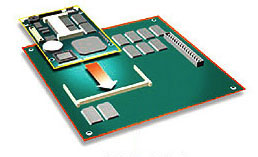 Once a design problem has been solved, there is no need to reinvent the wheel, but there is a need to keep up with new processor, interface and peripheral technologies. As a result, embedded systems often include two components. They consist of what's called a "solution" or "carrier" board that then accommodates a small System-On-Module (SOM) board that includes the CPU, chipset, memory and other core functionality. This approach frees designers and system integrators from having to design a whole new computer every time they switch processors. This way, they can design their solution, and then just pop in a new SOM. This means no more CPU integration concerns, always being able to offer the latest technologies, and getting to market very quickly. In fact, if you open some of the rugged machines we're reviewing here at RuggedPCReview.com, you'd find that many use this approach: they have a solution board and then a system-on-module based on speed and feature requirements. Once a design problem has been solved, there is no need to reinvent the wheel, but there is a need to keep up with new processor, interface and peripheral technologies. As a result, embedded systems often include two components. They consist of what's called a "solution" or "carrier" board that then accommodates a small System-On-Module (SOM) board that includes the CPU, chipset, memory and other core functionality. This approach frees designers and system integrators from having to design a whole new computer every time they switch processors. This way, they can design their solution, and then just pop in a new SOM. This means no more CPU integration concerns, always being able to offer the latest technologies, and getting to market very quickly. In fact, if you open some of the rugged machines we're reviewing here at RuggedPCReview.com, you'd find that many use this approach: they have a solution board and then a system-on-module based on speed and feature requirements.
Division of labor, and where Atom comes into play
What is the division of labor between the carrier board and the system-on-module? In general, the SOM handles the CPU as well as most of the basic circuitry. Often, the SOM covers 80% or so of all feature requirements. There are no hard rules, and designers often divide functionality according to project requirements. Simplicity is often key, as are reliability, fanless operation, cost, and power consumption. High performance may be required in some embedded systems, but a large number only need "targeted" performance, i.e. just enough to do the job at hand. This is why Intel's introduction of the Atom processors was applauded by embedded system designers. The Atom processor combines excellent efficiency with enough performance for applications where small size, thermal efficiency and power consumption matter. And since Atom processors are completely compatible with the full Intel Core microarchitecture instruction set, developers can use their existing compilers and software development tools.
Two Atom-powered System-on-Module CPU boards by Advantech
In this article, we're looking at two examples of Intel Atom-powered, both based on the COM-Micro and COM-Express standard, which use a very compact board footprint measuring just 3.74 x 3.74 and inches and 3.74 x 4.92 inches, respectively. Note that Advantech COM-Micro boards perform the same functions and also have the exact same pin definitions as the COM-Express series. The only difference is size.
The picture below shows the two boards. On the left is the square Advantech SOM-6760 with its tiny 1.6GHz Atom Z530 CPU on the left and the Intel System Controller Hub US15W on the right, making it a tightly integrated two-chip solution. On the right is the Advantech SOM-5761 CPU module with the 1.6GHz Atom N270 on the left, the Intel 945GSE in the middle, and the Intel ICH7M on the right.
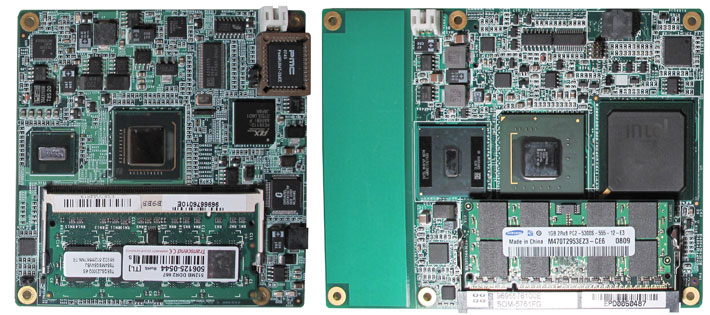
The Advantech SOM-6760 (Atom Z510 or Z530)
The SOM-6760 is a Intel Atom-based COM-Micro CPU module that can be ordered either with a 1.1GHz Intel Atom Z510 or a 1.6GHz Atom Z530 processor, both using the Intel System Controller Hub US15W. The module board measures 3.7 x 3.7 inches.
Instead of a CPU fan that can potentially fail, the SOM-6760 uses an aluminum heat sink that has the same footprint as the CPU board. The heatsink has two metal blocks corresponding to the two chipset components: the CPU itself, the US15W (22mm x 22mm) and the processor (13mm x 13mm). However, this heat spreader usually then works in conjunction with another heat sink or cooler.
The board has a single 200-pin SODIMM slot that can accommodate DDR2 400/533MHz RAM modules up to 2GB in size. On the underside of the board is a SD Card slot. Connection to the motherboard is via a special connector pair common to all COM-Express modules. The connectors have a total of 440 pins in four rows (A-D). The pins are combined into two strips of 220 pins each, X1 and X2, and are used for all communication between the SOM module and the carrier board.
The SOM-6760 board has the following features:
- It can be ordered with either a 1.1GHz Intel Atom Z510 or a 1.6GHz Intel Atom Z530
- Extremely low Thermal Design Power (CPU: 2.0 watts)
- Intel System Controller Hub US15W
- Supports 8 USB, EIDE, SDIO, 8-bit GPIO
- Intel 10/100 Mbps LAN
- Intel Graphcs Media Accelerator 500, DirectX 9
- H.264, MPEG2, MPEG4 hardware decoder
- Dual display support, and video up to 1600 x 1200 pixel
The Advantech SOM-5761 (Atom N270)
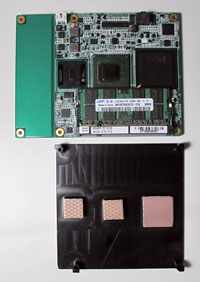 The SOM-5761 is a Intel Atom-based COM-Express CPU module that comes with the same 1.6GHz Intel Atom N270 processor used in millions of netbooks. The module board measures 3.7 x 4.9 inches (if the smaller 3.7 x 3.7 COM-Micro form factor is preferred, Advantech offers the SOM-6761 with the exact same electronics). The SOM-5761 is a Intel Atom-based COM-Express CPU module that comes with the same 1.6GHz Intel Atom N270 processor used in millions of netbooks. The module board measures 3.7 x 4.9 inches (if the smaller 3.7 x 3.7 COM-Micro form factor is preferred, Advantech offers the SOM-6761 with the exact same electronics).
Like the SOM-6760, instead of a CPU fan that can potentially fail, the SOM-5761 uses an aluminum heat sink that has the same footprint as the CPU board. The heatsink has three metal blocks corresponding to the three chipset components: the CPU itself, the 945GSE and the ICH7M. The heat spreader (the black part in the picture to the right) is designed to work in conjunction with another heat sink or cooler.
There is no SD Card on this board. The memory slot and connectors are the same as on all COM-Express boards.
The SOM-5761 board has the following features:
- Uses the 1.6GHz Intel Atom N270
- Extremely low Thermal Design Power (CPU: 2.5 watts)
- Chipset: Intel 945GSE/ICH7M
- Supports 8 USB, SATA, 8-bit GPIO
- Intel Gigabit LAN
- Intel GMA950, DirectX 9.1
- H.264, MPEG2, MPEG4 hardware decoder
- Dual display support, TV-out, and video up to 2048 x 1536 pixel
The SOM-DB5700
The SOM-DB5700 is an ATX form factor COM-Express development board that complies with the COM Express standard from the PCI Industrial Computer Manufacturers Group. It looks just like a standard ATX motherboard except for the sockets designed to accommodate a COM-Express or COM-Micro board.
Our test setup (shown below) consisted of a SOM-DB5700 development board, a full-size power supply (hidden behind the board in the picture below), a SOM-6760 CPU board, a 10.4-inch LCD, and Windows XP Embedded on a 2GB Apacer CF card. Everything was neatly mounted on a L-shaped acrylic stand -- perfect for testing.
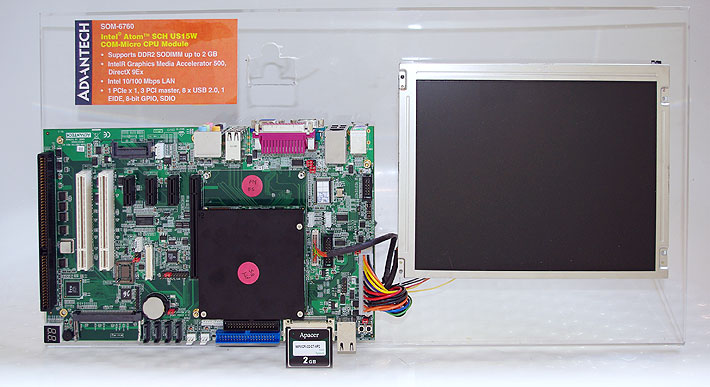
The 12 x 7.5-inch development board essentially offers a standard PC environment with PCI Express/PCI/ISA expansion interfaces and the following features and connectors:
- Accommodates any COM-Micro or COM-Express board
- 2 PCI slots
- 3 PCIe x1 slots
- 1 PCIe x16 slot
- 1 ISA slot
- 1 Express Card socket
- 1 CF Card socket
- 1 or 2 LVDS
- 1 standard VGA
- 1 TV-out
- 4 SATA Type B
- 1 EIDE
- 1 FDD
- 1 RS232, 1 RS232/422/485
- 1 LPT Parallel
- 2 PS/2
- 8 USB 2.0
-
The DB5700 development board is obviously a very flexible platform that covers a wide variety of interface, expansion and video technologies. In addition to the two Atom-based boards we tested, Advantech also offers COM-Express CPU modules with AMD and Intel Core 2 Duo processors.
Finally: a direct comparison of the N270 and Z530
For our purposes, this was a perfect opportunity for a direct comparison of two of Intel's most popular Atom processors. This was an unexpected bonues of our testing, but one that we appreciated a great deal. That's because there continues to be confusion about the difference between those two Atom processors, both of which are running at the same 1.6GHz clockspeed. While Intel originally targeted the Z5xx "Silverthorne" Atom processors at mobile internet devices (MIDs) and the N2x0 "Diamondville" processors at low-cost PCs and netbooks, the market seems confused and the two processor families seem to be used almost interchangeably. There are even product lines that offer essentially the same device in two versions, one with a Z-Series Atom chip and one with an N-Series.
There must be some CPU engineers who can authoritatively explain the pros and cons of the two families. For mere mortals and even geeky techheads like us, the chips appear almost the same. Various experts on the Web have praised the Silverthorne chips' accompanying "Poulsbo" chipset, which makes for an elegant 2-chip solution whereas the newer Diamondville processors must make do with two companion chips that are really just low-power versions of the old Intel 945 chipset. As is, the Z5xx chips do not support SATA but have integrated hardware decoding of high definition video and such, whereas the N270 and its companions do SATA, but no hardware decoding. Power consumption is very similar, with the processors both using a minuscule 2-2.5 watts, and the chipsets not much more.
It's always difficult to compare processors sitting in different hardware, but the Advantech development board and the two Atom CPU modules presented a unique opportunity to compare apples with apples. By simply popping the processor modules into the DB5700 board we had perfectly level playing field. Both boards booted and ran off the same 2GB CF Card with Windows XP Embedded, both had the same amount of RAM, both used the same displays (the LCD of the test setup and an external LCD).
For benchmarking we used both PassMark 7.0 and CrystalMark 2004R3, our standard benchmark suites. Here are the results (higher always better):
|
BENCHMARK PERFORMANCE
|
SOM-6760 (Atom Z530)
|
SOM-5761 (Atom N270)
|
|
PM 7.0: CPU Mark
|
315.6
|
321.1
|
|
PM 7.0: 2D Graphics Mark
|
207.2
|
192.5
|
|
PM 7.0: Memory Mark
|
191.6
|
199.1
|
|
PM 7.0: Disk Mark
|
70.7
|
74.6
|
|
PM 7.0: 3D Graphics Mark
|
19.6
|
71.5
|
|
Overall PassMark 7.0
|
137.3
|
190.7
|
|
CM 2004R3: CPU Alu
|
5376
|
5413
|
|
CM 2004R3: CPU FPU
|
4667
|
4726
|
|
CM 2004R3: Memory
|
3667
|
4172
|
|
CM 2004R3: HDD
|
2702
|
2676
|
|
CM 2004R3: GDI
|
2427
|
2239
|
|
CM 2004R3: D2D (Sprites)
|
1009
|
2180
|
|
CM 2004R3: OGL
|
505
|
704
|
|
Overall CrystalMark 2004R2
|
20353
|
22110
|
|
Playback 1280x720 HD movie in QuickTime
|
4-5 frames per second (choppy)
|
8-10 frames per second (choppy)
|
The results are amazing insofar as they are so much the same. Of the five PassMark test suites, the two processors scored virtually the same in four of them. The only (big) difference was in 3D Graphics where the N270 trounced the Z530. So while the N270's overall score was significantly higher, that's solely because of the 3D performance. The CrystalMark benchmarks showed pretty much the same, with the N270 again prevailing in most graphics tests, despite its much maligned chipset.
We decided to also install QuickTime and run a 70MB 1280 x 720 pixel high-def (720P) video. If the Z530 managed to apply any hardware decoding, we didn't see it as the N270 again ran faster. Both systems, however, had slow, choppy playback, but then again, this is what millions of netbook users get (the video playback is no better on our office Acer Aspire One netbook).
In terms of benchmark performance, these boards performed roughly at the 1.2GHz Core Solo or 1GHz Celeron M level, but under most circumstances they felt a whole lot faster. Unfettered by a lot of Window XP or Vista operating system overhead, these XP Embedded systems felt sharp and very responsive, and that's on a big 1600 x 1200 video display. There is no doubt whatsoever that both boards make for economical, low overhead solutions in any number of vertical and embedded markets.
Why pick an Atom-based COM-Micro or COM-Express board for your embedded project?
The COM-Express industry standard was created to provide embedded systems designers and integrators with boards that are available with a wide variety of CPUs, support state-of-the-art all-LVDS (Low-voltage differential signaling) interfaces, but still provide legacy support. The advent of Atom-powered boards means that COM-Express boards can now be had with inexpensive, modern, forward-looking processor families instead of slowed-down versions of older Intel chips. While we did not see significant performance differences between the two Atom-powered Advantech boards (other than 3D performance where the N270 board prevailed), designers may pick one or the other based on small but relevant spec differences.
Also, with Atom-based boards, using the proper drivers is extremely important. We saw drastic performance differences between default drivers and optimized drivers. Likewise, while Atom systems are inherently frugal, proper configuration of their power states and power management features is key to taking full advantage of these power-efficient designs.
Below are schematics of the two Atom-based Advantech modules:
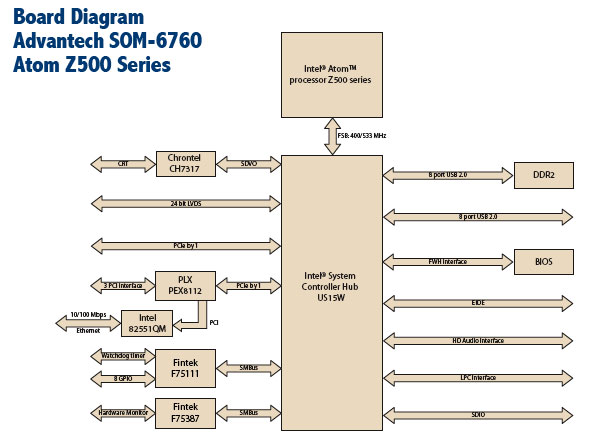

The side-by-side specifications below include data from both Advantech and Intel sources available online.
|
Advantech Atom-based COM-Micro CPU modules specifications
|
| PRODUCT |
SOM-6760 (Atom Z530) |
SOM-5761 (Atom N270) |
| Type |
COM-Micro CPU module |
COM-Express CPU module |
| Processor |
Intel Atom Z530 |
Intel Atom N270 |
| Processor codename |
"Silverthorne" |
"Diamondville" |
| Clock Speed |
1.6GHz |
1.6GHz |
| CPU Thermal Design Power |
2.0 watts |
2.5 watts |
| CPU package size |
13mm x 14mm |
22mm x 22mm |
| L2 cache |
512 KB |
512 KB |
| CPU transistors |
47 million |
47 million |
| CPU cores |
1 |
1 |
| Intel Virtualization Technology |
Yes |
No |
| Enhanced Intel Speedstep |
Yes |
Yes |
| Intel Demand Based Switching |
Yes |
No |
| Enhanced Halt State |
Yes |
No |
| Front Side Bus |
533MHz |
533MHz |
| BIOS |
AWARD 4MBit Flash |
AWARD 8MBit Flash |
| Chipset |
Intel System Controller Hub US15W |
Intel 945GSE/ICH7M |
| Chipset size |
22mm x 22mm |
27mm x 27mm |
| Chipset TDP |
2.3 watts |
6 watts (82945GSE) + 3.3 watts (ICH7M)
| Chipset code name |
"Poulsbo" |
"Calistoga" |
| Chipset tech documents |
see here |
see here |
| Memory |
up to 2GB DDR2 400/533MHz in one 200-pin SODIMM |
up to 2GB DDR2 400/533MHz in one 200-pin SODIMM |
| VRAM |
Shared system memory up to 256MB |
DVMT 3.0 supports up to 224MB |
| Graphics Engine |
Intel GMA 500; DirectX 9Ex; supports H.264, MPEG2/4 hardware decoder |
Intel GMA950; DirectX 9.1 |
| LCD |
24-bit single channel LVDS |
36-bit LVDS |
| VGA |
Up to 1600 x 1200 |
Up to 2048 x 1536 |
| Dual display |
CRT + LCD |
CRT + LCD, CRT + TV, LCD + TV |
| Ethernet |
Intel 8255 10/100 |
Intel 82574L 10/100/1000 |
| Watchdog Timer |
256 timer intervals from 0 to 255 sec or min, set up via software |
256 timer intervals from 0 to 255 sec or min, set up via software |
| PATA |
1 EIDE (UDMA 100) |
1 EIDE (UDMA 100) |
| SATA |
none |
2 x SATA (up to 150 MB/s) |
| USB |
8 x USB 2.0 |
8 x USB 2.0 |
| GPIO |
8-bit GPIO |
8-bit GPIO |
| Expansion |
LPC, 1 PCIe, 3 PCI master |
LPC, 3 PCIe, 4 PCI master |
| Expansion slots |
1 SD Card |
none |
| Audio |
High definition audio interface |
AC97, High definition audio interface |
| Power Consumption |
Typical: 5.7 watts; Max: 10.8 |
Typical: 7.4 watts; Max: 10.8 |
| Operating temp |
32 - 140F |
32 - 140F |
| Dimensions |
3.74 x 3.74 inches |
3.74 x 4.92 inches |
| Product brochure |
SOM-6760 |
SOM-5761 |
|
Advantech Corporation
38 Tesla, Suite 100
Irvine, CA 92618
Toll Free: 1-800-866-6008
Ph: 949-789-7178
Fax: 949-789-7179
ECGInfo@advantech.com
www.advantech.com
Advantech Co. Ltd.
No.1, Alley 20, Lane 26, Rueiguang Road
Neihu District, Taipei Taiwan 114, R.O.C.
Tel: 886-2-2792-7818
Fax: 886-2-2794-7301
www.advantech.com
|
|



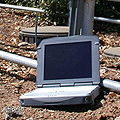

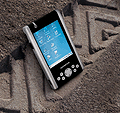
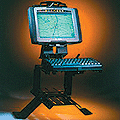





 Once a design problem has been solved, there is no need to reinvent the wheel, but there is a need to keep up with new processor, interface and peripheral technologies. As a result, embedded systems often include two components. They consist of what's called a "solution" or "carrier" board that then accommodates a small System-On-Module (SOM) board that includes the CPU, chipset, memory and other core functionality. This approach frees designers and system integrators from having to design a whole new computer every time they switch processors. This way, they can design their solution, and then just pop in a new SOM. This means no more CPU integration concerns, always being able to offer the latest technologies, and getting to market very quickly. In fact, if you open some of the rugged machines we're reviewing here at RuggedPCReview.com, you'd find that many use this approach: they have a solution board and then a system-on-module based on speed and feature requirements.
Once a design problem has been solved, there is no need to reinvent the wheel, but there is a need to keep up with new processor, interface and peripheral technologies. As a result, embedded systems often include two components. They consist of what's called a "solution" or "carrier" board that then accommodates a small System-On-Module (SOM) board that includes the CPU, chipset, memory and other core functionality. This approach frees designers and system integrators from having to design a whole new computer every time they switch processors. This way, they can design their solution, and then just pop in a new SOM. This means no more CPU integration concerns, always being able to offer the latest technologies, and getting to market very quickly. In fact, if you open some of the rugged machines we're reviewing here at RuggedPCReview.com, you'd find that many use this approach: they have a solution board and then a system-on-module based on speed and feature requirements.

 The SOM-5761 is a Intel Atom-based COM-Express CPU module that comes with the same 1.6GHz Intel Atom N270 processor used in millions of netbooks. The module board measures 3.7 x 4.9 inches (if the smaller 3.7 x 3.7 COM-Micro form factor is preferred, Advantech offers the SOM-6761 with the exact same electronics).
The SOM-5761 is a Intel Atom-based COM-Express CPU module that comes with the same 1.6GHz Intel Atom N270 processor used in millions of netbooks. The module board measures 3.7 x 4.9 inches (if the smaller 3.7 x 3.7 COM-Micro form factor is preferred, Advantech offers the SOM-6761 with the exact same electronics).


